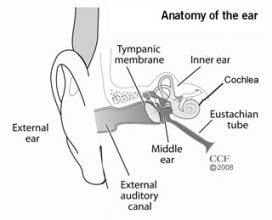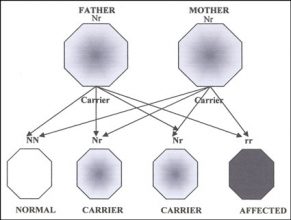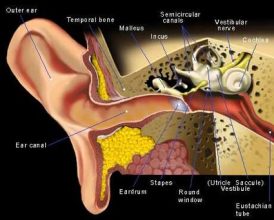Usher Syndrome
What is Usher Syndrome?
Usher Syndrome is an inherited disorder that affects hearing, vision and sometimes balance. The vision impairment is termed retinitis pigmentosa. Retinitis pigmentosa causes a progressive loss of vision. Initially, people have difficulty seeing in the dark. As the retina degenerates ‘tunnel vision’ results whereby there’s a loss of peripheral vision . The field of vision continues to narrow eventually leading to blindness.
Hearing loss may be present from birth or develop later and may worsen over time.

The extent of hearing loss and the rate of vision loss varies from person to person. Usher syndrome is considered to be a rare condition occurring in 3-6% of all people with a hearing loss. However, it is the most common cause of combined deafness and blindness.
Who is affected by Usher Syndrome?

It is a genetically inherited condition. An individual will have the condition if two defective genes that code for Usher Syndrome are passed on by parents to their child. It is therefore inherited repressively, meaning that both parents need to carry the gene for their child to develop the condition. There’s a 1/4 chance that a child will develop the syndrome if both parents carry the defective gene.
What are the different types of Usher Syndrome?
| Type | Characteristics |
|---|---|
| Type 1 | -Profound deafness from birth -Severe difficulties with balance -Vision problems generally develop before age 10 and vision loss tends to progress quickly resulting in blindness |
| Type 2 | -Moderate to severe hearing loss at birth -Normal balance at birth -Vision problems tend to begin in the teenage years and progress at a slower rate than vision problems in Type 1 |
| Type 3 | -Born with normal hearing and normal or relatively normal balance abilities -Balance difficulties may develop -Hearing loss develops over time, however the rate of progression varies -Vision loss also develops over time, however the rate of progression varies -Generally by age 50 individuals wear hearing aids and are blind |
How is the disorder diagnosed?
The disorder is generally diagnosed by conducting assessments on the three affected senses (hearing, vision and balance). Some genetic tests are available but due to the involvement of a number of different genes these tests are not yet conclusive.
The hearing assessment will be carried out by an audiologist and includes gathering a comprehensive case history, inspecting the ears with an otoscope (an instrument that allows for the visualisation of the auditory canal and the eardrum) and hearing tests. The information collected from this assessment allow the audiologist to determine the type and severity of hearing loss and will therefore guide decision making to select the most appropriate treatment options. Other tests conducted may include balance testing and vision testing.
Early diagnosis in children is important so that hearing, vision and balance can be treated and monitored. Addressing hearing loss early on is essential for the development of speech and language.
How is the hearing loss caused?
The genes involved in the syndrome play important roles in developing and maintaining the inner ear structures. Therefore, when these genes are defective the inner ear is either not properly formed at birth or is damaged over time.
The inner ear contains the cochlear and the vestibular system. The vestibular system is responsible for sending information to the brain about balance. Whereas, the cochlear is responsible for converting sound waves into electrical signals that are sent to the brain. Therefore, damage to the inner ear may result in hearing loss as well as balance problems.

Since the inner ear is affected, the hearing loss is a sensorineural hearing loss.
How can Usher Syndrome be treated?
Currently, there is no cure for the syndrome. However, there are various treatment options for managing hearing loss, vision impairments and balance issues. The best treatment option will depend on the individual’s circumstances and the severity and nature of the impairments.
The treatment options for hearing loss are discussed below according to the syndrome types.
Type 1
Individuals with type 1 are profoundly deaf from birth. Hearing aids do not benefit those with profound hearing loss since they function by amplifying sound. For sound amplification to be beneficial there must be some residual hearing. Cochlear implants may be suitable for those with profound hearing loss. A cochlear implant is inserted into the inner ear through a surgical process. Users wear a small microphone behind their ear that converts sound waves into an electrical signal. The electrical signal is then transmitted to the implant within the ear which stimulates the auditory nerve allowing the user to hear. Cochlear implants allow people to hear despite damage to the inner ear.
Other options for managing this hearing loss include learning sign language or other forms of communication.
Type 2
Those with type 2 Usher Syndrome are born with moderate to severe hearing loss. Hearing aids are usually effective in this population. There are a variety of hearing aids available. An audiologists will guide families and individuals in selecting the best hearing aid to suit the individual’s needs.
As the hearing loss may worsen over time, hearing should be monitored and hearing aids adjusted accordingly.
Type 3
Those with type 3 Usher Syndrome are born with normal hearing. Hearing progressively worsens over time. Hearing aids are generally beneficial in this population. As the person ages they may become profoundly deaf. In the case of profound deafness hearing aids will be of no benefit and cochlear implants may be a suitable option to restore hearing.
